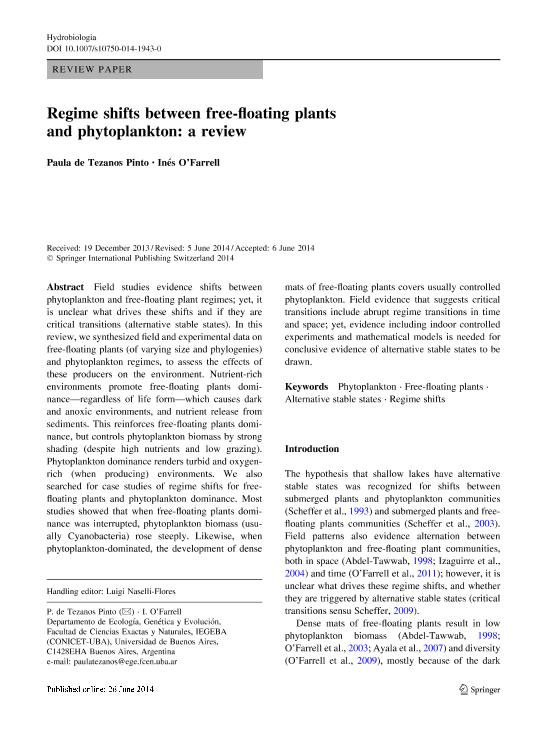Artículo
Regime shifts between free-floating plants and phytoplankton: a review
Fecha de publicación:
11/2014
Editorial:
Springer
Revista:
Hydrobiologia
ISSN:
0018-8158
e-ISSN:
1573-5117
Idioma:
Inglés
Tipo de recurso:
Artículo publicado
Clasificación temática:
Resumen
Field studies evidence shifts between phytoplankton and free-floating plant regimes; yet, it is unclear what drives these shifts and if they are critical transitions (alternative stable states). In this review, we synthesized field and experimental data on free-floating plants (of varying size and phylogenies) and phytoplankton regimes, to assess the effects of these producers on the environment. Nutrient-rich environments promote free-floating plants dominance—regardless of life form—which causes dark and anoxic environments, and nutrient release from sediments. This reinforces free-floating plants dominance, but controls phytoplankton biomass by strong shading (despite high nutrients and low grazing). Phytoplankton dominance renders turbid and oxygen-rich (when producing) environments. We also searched for case studies of regime shifts for free-floating plants and phytoplankton dominance. Most studies showed that when free-floating plants dominance was interrupted, phytoplankton biomass (usually Cyanobacteria) rose steeply. Likewise, when phytoplankton-dominated, the development of dense mats of free-floating plants covers usually controlled phytoplankton. Field evidence that suggests critical transitions include abrupt regime transitions in time and space; yet, evidence including indoor controlled experiments and mathematical models is needed for conclusive evidence of alternative stable states to be drawn.
Archivos asociados
Licencia
Identificadores
Colecciones
Articulos(IEGEBA)
Articulos de INSTITUTO DE ECOLOGIA, GENETICA Y EVOLUCION DE BS. AS
Articulos de INSTITUTO DE ECOLOGIA, GENETICA Y EVOLUCION DE BS. AS
Citación
de Tezanos Pinto, Paula; O'farrell, Ines; Regime shifts between free-floating plants and phytoplankton: a review; Springer; Hydrobiologia; 740; 1; 11-2014; 13-24
Compartir
Altmétricas




